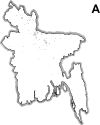Smallpox eradication in Bangladesh, 1972-1976
- PMID: 22188934
- PMCID: PMC5723923
- DOI: 10.1016/j.vaccine.2011.06.081
Smallpox eradication in Bangladesh, 1972-1976
Abstract
Rahima Banu, the world's last endemic case of severe smallpox, Variola Major, developed rash on October 16, 1975 on Bhola Island, Bangladesh. Achieving eradication in a country destroyed by war challenged the achievement of smallpox eradication. Between January 1, 1972 and December 31, 1975, 225,000 smallpox cases and 45,000 smallpox deaths occurred. Adapting the global smallpox eradication strategies of surveillance, the detection of smallpox cases, and containment, the interruption of smallpox transmission, utilized progress toward three objectives to monitor performance: (1) surveillance - the percent of smallpox infected villages detected within 14 days of the first case of rash, (2) knowledge of the reward - public knowledge of the current amount of the reward for reporting smallpox, and (3) containment - the percent of infected villages interrupting smallpox transmission within 14 days of detection. Failures to achieve these objectives led to the identification and implementation of improved strategies that eventually achieved eradication. Essential to this success was a tripartite partnership of the citizens of Bangladesh, the Bangladesh Ministry of Health, its field staff, and staff and resources mobilized by the World Health Organization.
Copyright © 2011. Published by Elsevier Ltd.
Figures











Similar articles
-
The Emergency campaign for smallpox eradication from Somalia (1977-1979)--revisited.Vaccine. 2011 Dec 30;29 Suppl 4:D36-40. doi: 10.1016/j.vaccine.2011.05.039. Epub 2011 Dec 18. Vaccine. 2011. PMID: 22185834 Review.
-
Experiences with smallpox eradication in Ethiopia.Vaccine. 2011 Dec 30;29 Suppl 4:D30-5. doi: 10.1016/j.vaccine.2011.10.001. Vaccine. 2011. PMID: 22486979
-
Lessons and innovations from the West and Central African Smallpox Eradication Program.Vaccine. 2011 Dec 30;29 Suppl 4:D10-2. doi: 10.1016/j.vaccine.2011.04.008. Epub 2011 Dec 19. Vaccine. 2011. PMID: 22188932 Review.
-
Lessons from the eradication of smallpox: an interview with D. A. Henderson.Philos Trans R Soc Lond B Biol Sci. 2013 Jun 24;368(1623):20130113. doi: 10.1098/rstb.2013.0113. Print 2013 Aug 5. Philos Trans R Soc Lond B Biol Sci. 2013. PMID: 23798700 Free PMC article.
-
Smallpox eradication after 30 years: lessons, legacies, and innovations. Introduction: meeting objectives, summary and final statement.Vaccine. 2011 Dec 30;29 Suppl 4:D3-5. doi: 10.1016/j.vaccine.2011.11.037. Vaccine. 2011. PMID: 22486978 No abstract available.
Cited by
-
"Remarkable solutions to impossible problems": lessons for malaria from the eradication of smallpox.Malar J. 2019 Sep 23;18(1):323. doi: 10.1186/s12936-019-2956-y. Malar J. 2019. PMID: 31547809 Free PMC article. Review.
-
Immunogenicity of poxvirus-based vaccines against Nipah virus.Sci Rep. 2023 Jul 14;13(1):11384. doi: 10.1038/s41598-023-38010-2. Sci Rep. 2023. PMID: 37452062 Free PMC article.
References
-
- Heitzman J, Worden RL, editors. Bangladesh: a Country Study. 2nd. Federal Research Division, Library of Congress; Washington, DC: 1989.
-
- Joarder AK, Tarantola D, Tulloch JL. The Eradication of Smallpox from Bangladesh. World Health Organization; Regional Publications; New Delhi: World Health Organization South-East Asia Regional Office; 1980. (South-East Asia Series No 8).
-
- Foster SO, Ward NA, Joarder AK, Arnt N, Tarantola D, Rahman M, Hughes K. Smallpox surveillance in Bangladesh: I -Development of surveillance containment strategy. Int J Epidemiol. 1980;9:329–34. - PubMed
-
- Hughes K, Foster SO, Tarantola D, Mehta H, Tulloch JL, Joarder AK. Smallpox surveillance in Bangladesh: II -Smallpox facial scar survey assessment of surveillance effectiveness. Int J Epidemiol. 1980;9:335–40. - PubMed
-
- Glasser JW, Foster SO, Millar DJ, Lane JM. Evaluating public health responses to re-introduced smallpox via dynamic, socially structured, and spatially distributed meta-population models. Clin Infect Dis. 2008;46S:182–94. - PubMed
Publication types
MeSH terms
Grants and funding
LinkOut - more resources
Full Text Sources
Medical

